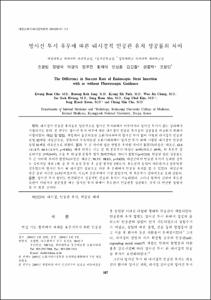KUMEL Repository
1. Journal Papers (연구논문)
1. School of Medicine (의과대학)
Dept. of Internal Medicine (내과학)
방사선 투시 유무에 따른 내시경적 인공관 유치 성공률의 차이
- Keimyung Author(s)
- Cho, Kwang Bum; Jang, Byoung Kuk; Park, Kyung Sik; Chung, Woo Jin; Hwang, Jae Seok; Ahn, Sung Hoon; Kim, Gab Chul; Kwon, Jung Hyeok
- Journal Title
- 대한소화기내시경학회지
- Issued Date
- 2004
- Volume
- 29
- Issue
- 3
- Abstract
- 목적: 내시경적 인공관 유치술은 일반적으로 방사선 투시하에서 이루어지나 방사선 투시가 없는 상태에서 시행되기도 한다. 본 연구는 방사선 투시 여부에 따른 내시경적 인공관 유치술의 성공률을 비교하기 위해서 시행되었다. 대상 및 방법: 계명의대 동산의료원 소화기내과에서 방사선 투시 없이 시행된 내시경적 인공관 삽입 82예를 대사군으로, 경북의대 부속의료원 소화기내과에서 방사선 투시 하에 시행된 내시경적 인공관 삽입 81예를 대조군으로 하였다. 결과: 두 군 사이의 평균 연령은 유의한 차이가 없었다.(대상군:대조군, 62.6±11.8세:66.3±11.3세, p=0.804). 폐쇄 위치는 식도 및 위 분문부가 대상군 44예(대조군 40예), 위 유문부 및 십이지장 15예(34예), 수술 후 위-공장 문합부 협착 23예(7예)로 차이가 없었다(p=0.210). 인공관 삽관 성공률도 두 군 사이에 차이가 없었다(대상군:대조군, 96.3%:98.8%, p=0.620). 대상군에서 인공관 유치가 실패한 경우는 십이지장 폐쇄 1예, 술 후 위-공장 문합 후 공장 협착된 2예로서, 유도철사 삽입이 어려웠거나 불분명한 경우였으며 방사선 투시 하 내시경적 삽관으로 바꾼 후 전례에서 인공관 유치를 할 수 있었다. 대상군의 평균 삽관 시간은 14.5분이었으며, 식도/위 분문부에서 가장 짧았으며, 위 유문부가 상대적으로 오래 걸렸다. 결론: 방사선 투시 없이도 안전하면서 성공적인 인공관 유치가 가능하였다. 그러나 협착이 심하여 유도관 삽관이 어렵거나 불분명할 때는 방사선 투시 하에서 유도관과 인공관을 삽관하는 것이 더 안전한 방법이 될 수 있을 것이다.
Backgroud/Aims: Sometimes, the endoscopic stent insertion may be done without fluoroscopic guidance. This study was performed to evaluate the difference in success rate of endoscopic stent insertion with or without fluroscopic guidance. A total of hundred and sixty three patients with upper gastrointestinal obstruction were included.
Methods: The group I comprised 82 patients in which the stent insertion was done without fluoroscopy. The group II included 81 patients in which stent was inserted under the fluoroscopy. Results : The locations of obstruction are at esophagus and cardia (group I /group II, 44/40 patients), at pylorus and duodenum (15/34 patients) and at post-operative stenosis of gastro-jejunal anastomosis (23/7 patients). The statistical difference of success rate were not found between the two groups [79/82 (96.3%) in group I, 80/81 (98.2%) in group II, p=0.620]. Among group I, three patients (3.7%) were failed due to incomplete guidewire insertion. These patients were the two cases of jejunal stenosis of esophago-jejunal anastomosis and one case of duodenal obstruction with carcinomatosis peritonei. However, in these cases, the stents were successfully inserted under the fluoroscopic guidance.
Conclusion: The success rate of the endoscopic stent insertion with or without the fluoroscopic guidance is not different. But in cases of inaccurate guidewire insertion, especially in patients with pyloric obstruction, the endoscopic stent insertion under the fluoroscopic guidance may be more safe and successful.
- Alternative Title
- The Difference in Success Rate of Endoscopic Stent Insertion with or without Fluoroscopic Guidance
- Publisher
- School of Medicine
- Citation
- 조광범 et al. (2004). 방사선 투시 유무에 따른 내시경적 인공관 유치 성공률의 차이. 대한소화기내시경학회지, 29(3), 107–113.
- Type
- Article
- ISSN
- 1225-7001
- Appears in Collections:
- 1. School of Medicine (의과대학) > Dept. of Internal Medicine (내과학)
1. School of Medicine (의과대학) > Dept. of Radiology (영상의학)
- 파일 목록
-
-
Download
 oak-bbb-2063.pdf
기타 데이터 / 206.31 kB / Adobe PDF
oak-bbb-2063.pdf
기타 데이터 / 206.31 kB / Adobe PDF
-
Items in Repository are protected by copyright, with all rights reserved, unless otherwise indicated.